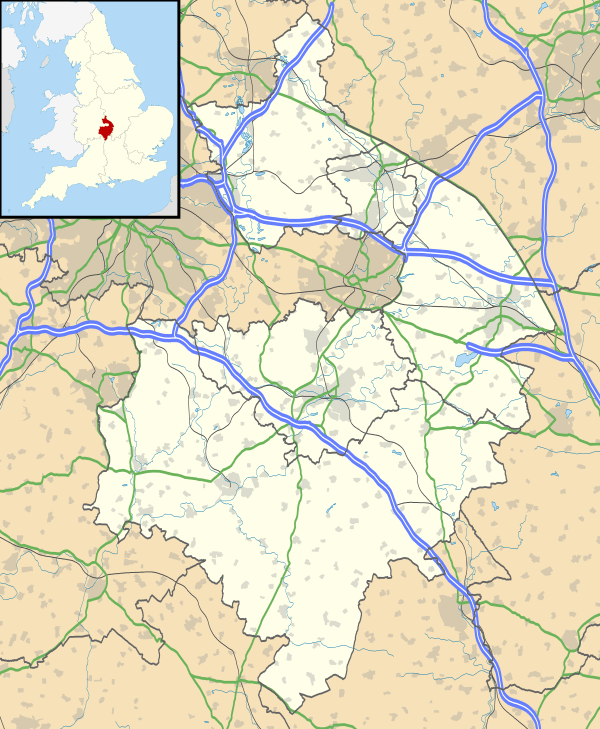Lord Leycester Hospital
| Lord Leycester Hospital | |
|---|---|
|
Lord Leycester Hospital | |
| Location | Warwick, Warwickshire, England |
| Coordinates | 52°16′47.05″N 1°35′27.62″W / 52.2797361°N 1.5910056°WCoordinates: 52°16′47.05″N 1°35′27.62″W / 52.2797361°N 1.5910056°W |
| Built | 1571 |
| Built for | Robert Dudley, 1st Earl of Leicester |
Listed Building – Grade I | |
 Location of Lord Leycester Hospital in Warwickshire | |
The Lord Leycester Hospital (often known simply as the Lord Leycester) is a retirement home for ex-Servicemen in Warwick, England, that is located next to the West Gate, on High Street.
Buildings and composition
The Hospital comprises the medieval Chapel of St James the Great, living quarters (including the Master's House), a Guildhall (with anterooms) and a Great Hall. Also contained within the establishment are the Master's Garden and the Museum of the Queen's Own Hussars. The hospital is a grade I listed building.[1] The surrounding grounds are separately listed.
History

The Chantry Chapel of St James was built in 1126 by Roger de Newburgh, 2nd Norman Earl of Warwick. In the late 14th century it was rebuilt by the 12th Earl of Warwick. He granted the benefice of the Chapel to the Guild of St George, a guild created on 20 April 1383 under licence from King Richard II. The Guild of St George was later joined there by the Guild of the Blessed Virgin, which had been based at the Collegiate Church of St Mary, forming the United Guilds of Warwick. Living quarters and reception, meeting, and dining halls were added to the chapel as a consequence. The Guildhall was built in 1450 by the 16th Earl of Warwick.
The United Guilds were dispersed by King Henry VIII in 1546. However, their property had already been transferred to the Burgesses of Warwick by Thomas Oken, Master of the Guilds. The 1st Earl of Leicester acquired the buildings in 1571, founding therein a hospital for aged or injured soldiers and their wives, under royal charter from Queen Elizabeth I, run by 12 resident "Brethren" (originally soldiers) under the charge of a "Master", and funded from the income of various estates. This lasted until 1950. Between 1881 and 1930 the hospital served as a terminus for the Leamington & Warwick Tramways & Omnibus Company, the other end being close to Leamington Spa railway station.
In 1956 the Corporation of the Master and Brethren of the Hospital was abolished by Act of Parliament, having operated under the original charter for nearly 400 years, and replaced with a board of Governors. On 3 November 1966 a restored Hospital with modernised quarters was opened by Queen Elizabeth the Queen Mother, and today the Hospital is run by the Master, a retired officer of the Armed Forces. Eight ex-servicemen and their wives are provided with flats in return for their past services. The Hospital is funded by visitor income, the original estates having been sold over the years.
Other historical notes of interest:
- The Grade I listed stone urn in the Master's Garden is 2,000 years old and was originally part of an Egyptian nilometer. [2]
- A banquet held for King James I at the Great Hall put the town of Warwick into debt for ten years.
Television appearances
The building has been used in many historical-set television productions including Pride and Prejudice, Tom Jones, Moll Flanders and the 2007 Doctor Who episode The Shakespeare Code. It was also featured in David Dimbleby's 2007 documentary series, How We Built Britain.
References
- ↑ "Name: HOSPITAL OF ROBERT DUDLEY EARL OF LEICESTER List entry Number: 1035441". English Heritage. Retrieved 26 August 2014.
- ↑ "Name: EGYPTIAN URN IN GARDEN OF LORD LEICESTERS HOSPITAL List entry Number: 1364812". English Heritage. Retrieved 15 September 2014.
- "Get inside Warwick's secret historic film set". BBC Coventry and Warwickshire. Retrieved 26 July 2005.
- "The Lord Leycester Hospital, Warwick". British history articles. Retrieved 26 July 2005.
External links
| Wikimedia Commons has media related to Lord Leycester Hospital. |

